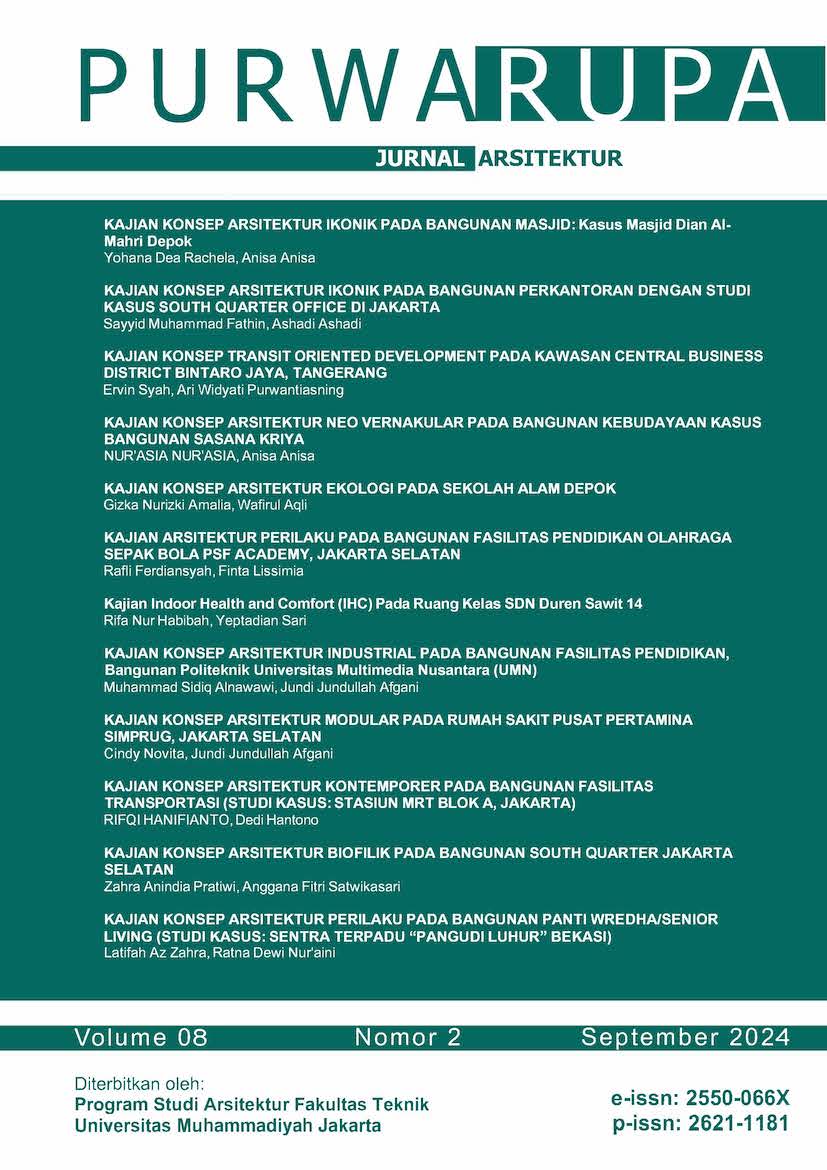KAJIAN KONSEP ARSITEKTUR IKONIK PADA BANGUNAN PERKANTORAN DENGAN STUDI KASUS SOUTH QUARTER OFFICE DI JAKARTA
DOI:
https://doi.org/10.24853/purwarupa.8.2.99-106Abstract
ABSTRAK. Pada masa saat ini arsitektur berkembang semakin pesat karena banyaknya konsep arsitektur yang berkembang, salah satunya adalah munculnya bangunan-bangunan ikonik di berbagai tempat bagian dari dunia. Bangunan ikonik merupakan bangunan yang menandai suatu tempat atau suatu zaman, bangunan ikonik seringkali terletak di lokasi strategis seperti persimpangan jalan, taman dan ruang terbuka. Keberadaan bangunan ikonik memberikan dampak yang besar terhadap daerah sekitarnya, bahkan mampu memasarkan wajah kota di masing-masing negara. Seiring berjalannya waktu banyaknya bangunan yang dikatakan ikonik belum memenuhi indikator ikonik karena masih minimnya makna dan penerapan ciri-ciri ikonik pada bangunan tersebut. Oleh karena itu, perlunya penulis melakukan penelitian terkait konsep arsitektur ikonik, dengan studi kasus, South Quarter Office. Sedangkan metode yang akan diterapkan adalah deskriptif kualitatif. Hasil penelitian menunjukkan bahwa bangunan South Quarter Office merapkan konsep arsitektur ikonik yang di perlihatkan oleh ciri-cirinya yaitu: Bentuk bangunan yang atraktif secara visual. (attractive form), Bentuk yang simetris pada bangunan (simetrical form), Elemen berulang pada fasad (continuous rhythm), Memiliki pesan atau makna spesifik (specific signified by the building), Berada pada lokasi yang strategis (strategic location), Bentuk metafora (Metaphor Forms), Teknologi bangunan kekinian (Contemporary building technology). Kata Kunci: arsitektur, ikonik, bentuk, atraktif, metafora ABSTRACT. At this time architecture is growing rapidly because of the many architectural concepts that have developed, one of which is the emergence of iconic buildings in various parts of the world. Iconic buildings are buildings that mark a place or an era, iconic buildings are often located in strategic locations such as crossroads, parks, and open spaces. The existence of iconic buildings has a great impact on the surrounding area, even being able to market the face of the city in each country. Over time, many buildings that are said to be iconic have not met the iconic indicators because of the lack of meaning and application of iconic characteristics in the building. Therefore, the author needs to conduct research related to iconic architectural concepts, with a case study, South Quarter Office. The method to be applied is qualitative descriptive. The results showed that the South Quarter Office building applies the iconic architectural concept shown by its characteristics, namely: The shape of the building is visually attractive. (attractive form), A symmetrical form on the building (symmetrical form), Repeating elements on the façade (continuous rhythm), Have a specific message or meaning (specific signified by the building), Be in a strategic location (strategic location), Metaphor forms (Metaphor Forms), Contemporary building technology (Contemporary building technology). Keywords: architecture, iconic, form, attractive, metaphorReferences
Aatty, H. M. S., & Al Slik, G. M. R. (2019). Iconic architecture and sustainability as a tool to attract global attention. IOP Conference Series: Materials Science and Engineering, 518(2). https://doi.org/10.1088/1757-899X/518/2/022076
Broadbent, G. (1973). Design in architecture; architecture and the human sciences. John Wiley & Sons.
Elhagla, K., Nassar, D. M., & Ragheb, M. A. (2020). Iconic buildings’ contribution toward urbanism. Alexandria Engineering Journal, 59(2), 803–813. https://doi.org/10.1016/j.aej.2020.01.020
Ida Nuraida. (2008). Manajemen Perkantoran. PT Kanisius.
Joyce Meilanita. (2017, April). 10 Elemen Rahasia Arsitektur Ikonik. Arsitag.
Leslie Sklair. (2017). The Icon Project: Architecture, Cities, and Capitalist Globalization. Oxford University Press.
Prajudi Atmosudirdjo. (1981). Hukum administrasi negara. Ghalia Indonesia.
Rahadian, E. Y., Wahab, F., Syaputra, H., & Setiawan, A. (2013). Kajian Karakteristik Bangunan Ikonik Pada Gedung Puspa Iptek Kota Baru Parahyangan. In Jurnal Reka Karsa © Jurusan Teknik Arsitektur Itenas | No.I | (Vol. 1).
Sedarmayanti. (2009). Sumber Daya Manusia Dan Produktivitas Kerja. CV Mandar Maju.
Udjianto Pawitro. (2012). Perkembangan ‘Arsitektur Ikonik’di Berbagai Belahan Dunia. Majalah Ilmiah TRI-DHARMA, 1–9.
Downloads
Published
How to Cite
Issue
Section
License
COPYRIGHT POLICY
The author(s) of an article published in the Jurnal Teknologi retains ownership of the intellectual property rights in work (s).
PUBLISHING RIGHTS
The author(s) of an article published in the Jurnal Teknologi have unrestricted publication rights. The authors give the Jurnal Teknologi the right to publish the article and designate the Faculty of Engineering Universitas Muhammadiyah Jakarta Publishing as the original publisher of the article.
LICENSING POLICY
Journal of Mechanical Engineering and Sciences is an open-access journal that follows the Creative Commons Non-Commercial 4.0 International License (CC BY-NC 4.0), which states that:

Under this license, the reusers must give appropriate credit, provide a link to the license, and indicate if changes were made. Users may do so in any reasonable manner, but not in any way that suggests the licensor endorses users or their use.
Please take the time to read the whole license agreement (https://creativecommons.org/licenses/by-nc/4.0/). As long as reusers follow the license conditions, the owner cannot withdraw these freedoms. The following components are included under this license:
 Attribution: Users must provide appropriate attribution, including a link to the license, and indicate whether or not they made any modifications. Users are free to do so reasonably, but not in a manner that indicates the licensee approves of their usage.
Attribution: Users must provide appropriate attribution, including a link to the license, and indicate whether or not they made any modifications. Users are free to do so reasonably, but not in a manner that indicates the licensee approves of their usage.
 NonCommercial: Users may not use the material for commercial purposes.
NonCommercial: Users may not use the material for commercial purposes.

